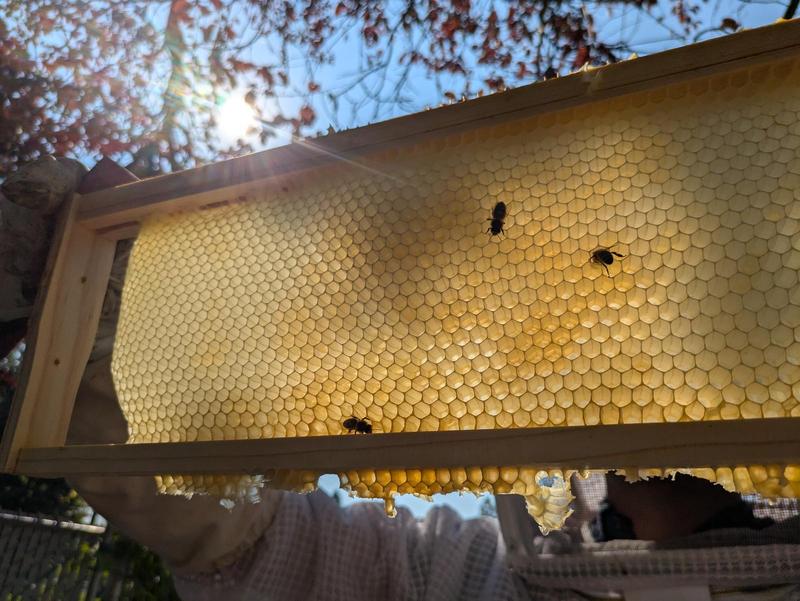
Beekeeping Year 2 Recap: Splitting Hives, Harvesting Honey, Readying for Winter
There's nothing quite like spreading a gleaming spoonful of honey and comb, just scooped from the hive, onto a slice of fresh, warm bread. Our kids don't know how good they have it!

Our bees were busy this year! This was our second year as beekeepers. Last I updated in May, Hive #4 was strong coming out of winter. Hive #3 was dead, and we had just split Hive #4 to restart that one. Hives #1 and #2 were on a slow decline so we had been attempting to split Hive #4 again to restart them as well.
The Hive #3 split was successful! We found a new queen in June; she was soon laying eggs and the hive was buzzing away. Hive #3 and Hive #4 stayed strong all summer and produced a great deal of delicious honey—more on that below.
The splits into Hives #1 and #2 were not successful. Though we made several attempts in early summer, neither hive really got off the ground, though they did requeen. Neither #1 nor #2 produced honey for us this year; neither grew strong enough to make it through winter. That's disappointing, but from what we've heard from other beekeepers, is on par for our area. Some years are great. Some are not.
We put screened bottom boards in all the hives this year for the summer to help with air flow and mite control. When the bees groom themselves, the mites fall off. If they fall all the way out of the hive through the screened bottom onto the ground, they're not likely to make it back in. With a solid board, however, they're likely to climb right back up onto the bees. We tried a powdered sugar treatment to help with mite control, too: dump powdered sugar at the top of the hive, it gets on the bees, they are triggered to groom themselves, more mites get cleaned out. It's unclear how well it worked since we didn't have a control hive to test against… fortunately, this beekeeper has written in detail about the process and effectiveness.



Honey Harvest
We harvested honey from Hives #3 and #4 in early September—17 frames from Hive 3 and 17 frames from Hive 4. This is more honey than we took from the hives last year!
To improve the process this year, we made an uncapping tank, like this, with a queen excluder in a plastic bin.



We also upgraded our extractor to a motorized stainless steel extractor. The hand drill-powered 5-gal bucket extractor worked okay last year, but it wasn't meant for a larger backyard operation.
Some friends brought their kids over to see the process. We had a good day of it and extracted about 10 gallons of honey.









The Case of the Missing Bees
When we checked on the bees later in the fall, we discovered that Hives #1 and #2 were completely dead and both Hives #3 and #4 had mysteriously absconded. It's a bummer! We thought we would be heading into winter with two strong hives. We have no clue what happened, and there's no way to know. One week the bees were there; we harvested honey; then when we next checked in, no bees. Bees may leave for all kinds of reasons—mites, disease, overcrowding, lack of forage, invasion by beetles or ants or wasps, among other reasons.
We're disappointed. But, so it goes up here. One beekeeper we've talked to, who has 12 hives, sometimes has 2 survive a winter, and sometimes 10. Sometimes it's a good honey year; sometimes not. He also told us that since this was Hive #4's second year, it would probably be a good idea to requeen that hive next spring anyway, since the queens do get less productive with age.
Anyway, since we didn't have any bees who needed the remaining honey stores in the hives, we decided to harvest the remainder. We got another three gallons, bringing us up to 13 gallons total.

Plans for next year
In the spring, we will get new nucs to restart all the hives. It won't quite be like starting from scratch, however, because over the past two years, our bees built out the wax on a lot of frames in a lot of supers. We can give the new bees all these frames, which will be a big head start, since they won't have to make that much wax.
It's always an adventure.

4 Years Blogging: Why write?
